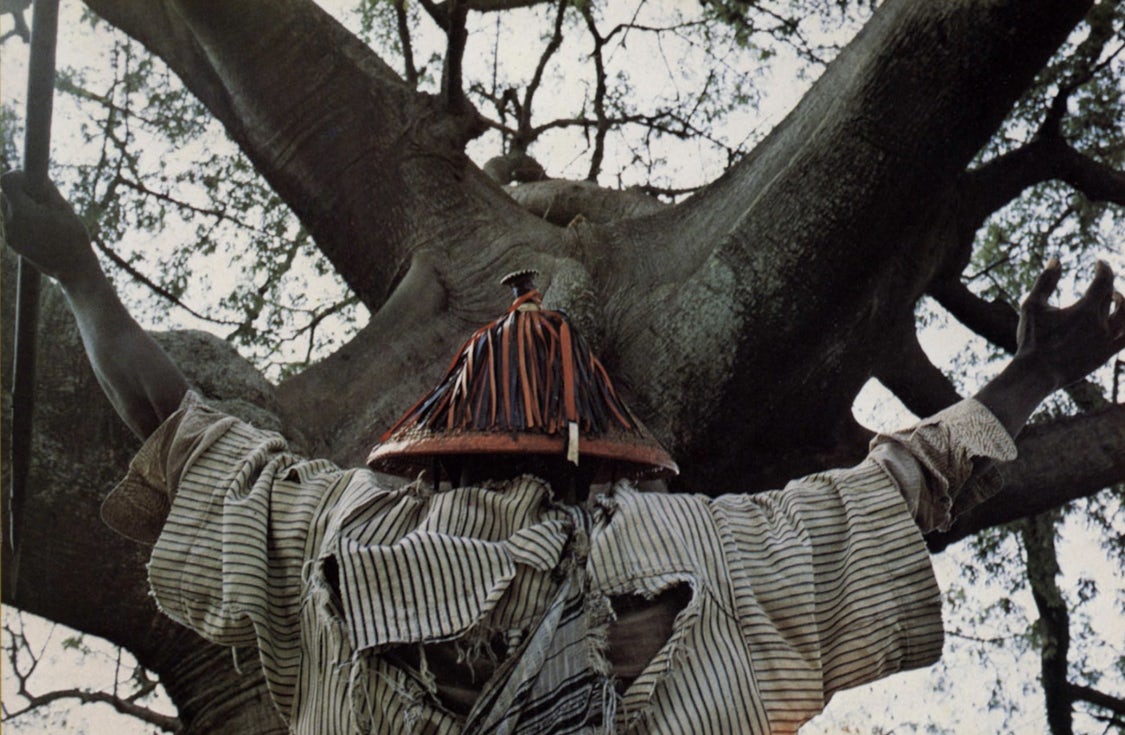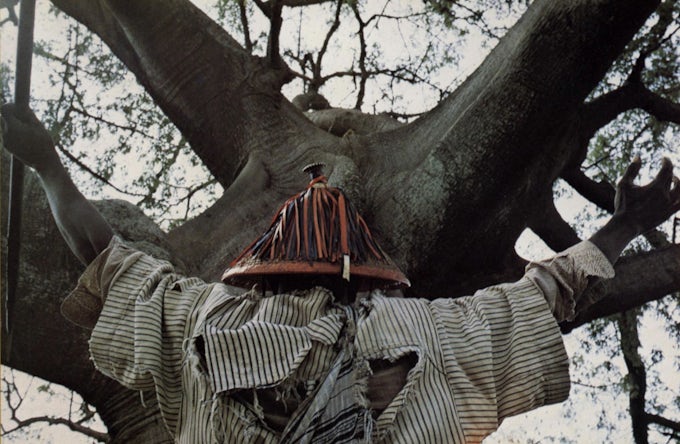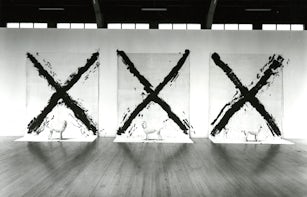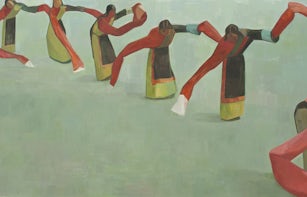In The Archaeology of Knowledge, Michel Foucault writes:
‘The archive is first the law of what can be said, the system that governs the appearance of statements as unique events. But the archive is also that which determines that all these things said do not accumulate endlessly in an amorphous mass, […] they are grouped together in distinct figures, composed together in accordance with multiple relations, maintained or blurred in accordance with specific regularities; that which determines that they do not withdraw at the same pace in time, but shine, as it were, like stars, some that seem close to us shining brightly from afar off, while others that are in fact close to us are already growing pale.” 01
We have quoted this text at such length only to better insist on the theme that its enunciation opens up. The astronomical metaphor that closes gives the exact reading (or hearing) of the bronze voice of an old blind man praising the exploits of the Achaeans under the walls of Troy, while numerous discourses (including this one, despite being written) vanish as soon as they are pronounced. The relationship to speech, as an exercise in memory, framed by the laws that preside over what is enunciated and conditions listening, founds the engendering and rupturing protocols of the ancient and modern in the act through which we relate to one another. Identifying the dividing lines of these knowledges in Africa is what we devote ourselves to here.
If the arche is accompanied by the decreeing of the nomos, that is because it traces the boundary of the sayable and of the unspeakable. The unspeakable: what cannot be said yet, ‘for it takes time, even for starlight, to reach men’ (another stellar metaphor, from The Gay Science, this time). Or the unspeakable, as what, at the threshold of the will-to-say, fails to speak itself; ‘what cannot rise to the tongue because it has not risen to the heart’ to use Saint Augustine’s words that summarise the tradition of negative theology. Or yet, the unspeakable as closure to the access rigorously controlled by the hierarchy of speeches and of speaking beings decreed by initiation. In any case, relating ancient knowledge to modern knowledge, is to think the laws that govern them, modalities under which they are given, the locus from which the questions we ask them germinate, the nature of the links or the ruptures that we believe we discover and whose relevance must be established each time.
Our fundamental thesis is to maintain, along with a few authors, that traditional African civilisations are civilisations of orality02. In other words, civilisations that do not use or make only marginally use of the medium of writing, in which messages are ‘winged speeches that fly from mouth to ear’ according to Homer’s beautiful formula. Hence the following hypothesis: if traditional knowledges are produced by oral cultures, whereas modern knowledges stem from scriptural practices, it is to be expected that they will present specific traits in their production, their organisation and the modalities of their transmission. Indeed, in an oral culture, remarkable phenomena happen, which are absent or do not have the same function as in a scriptural culture. One can signal, among others, the frequent use of images and metaphors and staging in the form of a story, which at the end, delivers a lesson to remember.
Commenting on a text by Hieronymus (reported by Diogenes Laërtius) narrating how Thales measured the height of the pyramids according to their shadows, Michel Serres makes the following remark: ‘Myth, then, mythical narrative, is less an originary legend than the form of transmission itself03. Drawing all the consequences from this affirmation, we also attempted to establish the idea according to which there is a ‘logic of orality’ that corresponds to the ‘logic of writing’ brought out by Jack Goody04. The intense use of images and dramatization in all the productions of traditional oral cultures is due to specific constraints connected to the oral fact itself. One can demonstrate it systematically, since the elementary acts of language such as the proverb or the maxim to the myth, all through the tale and the historical argument05. It is for reasons of convenience and to hold on to our theme that we will set aside the proverb, even if an author such as Jean Cauvin claims, with regards to the Minyanka people of Mali: ‘The Minyanka man “says” and “makes” his society through proverbs.’06 It is rather Agblemagnon’s tale that will retain us, of which he asks ‘if, in an African society without writing, it is simply a “superstructure” or on the contrary an integral part of the structure’07. Its importance comes from the fact that ‘this game, this staging, this theatricalisation, this imagination even are nothing more, in a sense, than a rehearsal for ‘fun’, to ‘see’, the fundamental mechanisms of society which, in this way, really dismantled, performed and not only imagined’08. A double archive in which the group mirrors and exposes itself, the tale gives a true object-based lesson, according to Dominique Zahan: ‘Therefore, the Bambara will illustrate the most abstract themes through the mediation of the elephant, the hyena, etc., chosen according to the idea that must be expressed through them.’09
The themes at stake may concern typical social practices, a natural or cultural characteristic, a specificity of the local flora or fauna, or phenomena such as eclipses. In any case, the tale is a ‘theatre of thesis’ staging characters and sequences of varying numbers and lengths to reach a conclusion that, at the end of its narration, delivers a ‘lesson’. Perfect illustration of the ‘cunning of oral reason’, it makes one retain one or several ‘truths’ whose mere undramatised enunciation does not allow for easy or durable immobilisation. In the syllogism of dramatised narrative art, opening statements are the premises that progressively lead the audience to a conclusion whose enunciation can be accompanied by a peremptory quod erat demonstrandum (which was to be demonstrated). Dramatisation is therefore not a formal and supererogatory envelope, it is the pedagogical support adapted to the oral context. Indeed, to recall the ‘truth’ of the tale, it is enough to re-actualise the ‘narrative contract’. The tale does not only annex the terrain of the of the imaginary to make one dream; it tells the values and anti-values of the social group through the process by which the archive constitutes itself. On that level, it competes with history.

In an oral context, history casts itself preferentially in the mould of the epic. The latter is the mode of constitution of the memorable, which proceeds through superlativisation around ‘great names’ and ‘great deeds’ in order to wrest them from contingency. The words of the narrator of epics are, consequently, revealing: ‘Without us the names of kings would fall into oblivion, we are the memory of men […] we teach the rabble what we want to teach them, it is we who hold the keys to the twelve doors of Mandingo.’10 Historical archiving, especially in the absence of written material, asks more clearly than elsewhere these questions that are vital for any society: ‘Who has an interest in remembering?’ and ‘Who has interest in sharing their memory and, if needed, provides themselves with the means to oblige others to share it?’11 The articulation of (historical) knowledge and of (political) power, in short the ‘interest one takes in history’, in the sense of Moses I. Finley, sheds light, partly, on what has been called ‘the struggle for history’, in the complex project of reappropriating the past by African societies.12
But more than the archive, it is perhaps archaeology that better accounts for the management and transmission of the memorable, as the law of what can be said is enacted according to a tiered structure from the most superficial to the most profound. Relative to the first level, which everyone can access, are proverbs, sayings, tales and, in a sense, history even. The deepest core is constituted by initiatory knowledge that itself includes different levels.
In what can function as a frontispiece, the initiatory Fula text Kaidara says, speaking of itself according to the qualification of its addressees: ‘I am futile, useful, instructive.’
Here is played out the essential-fundamental, the inversion of the law and of the signs depicted by the great initiated Bagoumawel in L’éclat de la grande étoile (‘The Shine of the Great Star’), the only man to have attended without dying the nocturnal conciliabule of the Baobab, the Elephant and the Vulture:
This little man lived alone.
His manners had nothing in common with anybody
[…]
Everything he did, you found it contrary to custom
He deviated from custom, tore habits apart.13
The initiated ‘tears up habits’, transgresses the common law, because he is governed by what is inopportune. The regime of initiatory legality is primarily institutional. The opposition between the sacred and the profane declares a system of exclusion clearly established in Koumen: ‘People from within do not go outside, and those from outside do not go inside. The area is guarded by an old man who has only one black hair.’14 Furthermore, the law is a code that produces different levels in the field of knowledge, by linking the oppositive duality initiated/non-initiated to a hermeneutic access key. For our part, our reading of Kaidara is one in which there is perhaps not the initiation to a determined knowledge (as the secret name of the bovid in Koumen), but the initiation staging itself, in other words, an initiation to the initiation. The death of all of Hammadi’s companions during the journey places initiatory knowledge under the sign of radical exclusion. What is more, Kaidara himself, after having instructed Hammadi, gives him this final recommendation:
Hammadi, every wise man
keeps his sheep in a well-enclosed pen
just as Gueno locks up
the secret in pure hearts
or in awakening brains.
Never does a good man, to the sound of a guitar
boast: he hides his secret like virginity
that Gueno spares and watches over on purpose.15
The supreme law of initiation is hence that of the secret, of unshared knowledge. It even happens that the secret is staged, as in the ninth symbol of K aïdara. Or when the name of the hermaphrodite ox is revealed to Silé during his sleep: ‘I will give you the name, but you will keep it for yourself. You will whisper it to the ear of your successor, at the moment when your soul is summoned to the session of the twelfth clearing where Doundari sits and decides of the last spells.’16 Reedy whispered voice, the secret makes operative the absolute reduction of the distance that separates the mouth from the ear in ordinary communication. It is a non-communication only for the layperson, this selective communication par excellence, which, at the heart of initiatory knowledge, chooses its addressee. Everywhere and always, initiation claims the words that open the Peri physe ōs (On Nature): ‘Hear thou, Pausanias, son of wise Anchitus! […] Shelter these teachings in thine own mute breast.’17 Dominique Zahan can therefore write: ‘The verb is there only to allow the valorisation of its absence. By giving birth to the speech, silence engenders itself, so that it is legitimate to say […] that the great reality is not the verb, but its defect.’18
Interrogating the relationships between traditional knowledge and modern sciences fundamentally amounts to problematising the relationships between two modes of archiving that concern, respectively, the written and the oral, publicity and secrecy. In short, and because one can refer to authors such as Goody or Havelock for writing,19 we will recall Cheikh Anta Diop’s insistence on the fact that the Greeks, whose role in the advent of philosophical and scientific rationality is well known, drew (without always admitting it), as with the Dogon and the Yoruba, on the Egyptian source.20 In Civilization or Barbarism, he claims that the bifurcation took place after: ‘It is in the metaphysical field that the Greek differs radically from the others’, having departed from its initial model, ‘[b]ut the African initiatory tradition degrades the quasi-scientific thoughts that it received during very ancient periods, instead of enriching them with time’. We have at times discussed his idea that a ‘principal idea that exists everywhere in Black Africa is that of initiation at different levels or degrees, and one which contributed greatly to the degradation and the fossilization of knowledge that was earlier considered to be quasi-scientific’.21 The lesson we draw from this is that the initiatory institution has been an obstacle to the dissemination of knowledge, and its critical questioning one of the conditions for its development.22
The formidable adventure of the Greeks benefited from a convergence of factors, including writing, the creation of a political space with no precedent in their history and public speech in the agora outside of the circle of Mysteries. In the Apology, Socrates makes a claim that itself suffices to break the closure of all initiatory institutions and knowledge:
‘I have been always the same in all my actions, public as well as private, and never have I yielded any base compliance to those who are slanderously termed my disciples or to any other. […] but anyone, whether he be rich or poor, may ask and answer me and listen to my words; and whether he turns out to be a bad man or a good one, that cannot be justly laid to my charge, as I never taught him anything.’23
The locus of debate as a public space of principled interchangeability of interlocutory positions, under the arbitration of reason alone, is rigorously incompatible with the very concept of initiation. Graphic reason is accused in the Phaedrus of being ‘a logos without father’. Yet, Derrida notes in Dissemination that the accused, ‘Theuth […] spoke not another word’. One might add: wrongly so.24 Or, rather, he did not need to: without the formidable writer Plato is, would we have inherited the words of Socrates, ‘the one who does not write’? It is perhaps necessary to subvert the very terms of the act of indictment: because it is offered to everyone, graphic reason is ‘the most widely shared thing in the world’. Its subject is an empty place that can, by law, be occupied by anyone.
*
So, what task or set of tasks present themselves to the African researcher? To cut a long story short: to imagine the absent plea of the god of writing. To make a global claim, what is needed in order to cease being on the periphery of the process of knowledge accumulation, is to settle the accounts of a ‘double memory’, to undo a conflict at the heart of the archive. This is a theoretical decision which involves a responsibility and demanding methodological protocols, with an attitude of critical reappropriation, from which any substantialist vision and their judgements of value would be absent.
To think how men, faced with a challenge that every civilisation must rise to, namely, the production, management and transmission of their heritage, have dealt with it, with the means at their disposal, to imagine ‘cunnings’ of the intelligence susceptible to master the real, is already laying the foundations of a programme. The description, as precise as possible,25 of the archaeology of these knowledges should lead to projects of general and regional epistemology that may hold many surprises.
Beyond utilitarianism, which proceeds by the elimination of what we could call the ‘mystical gangue’ of ancient knowledges to find the ‘rational kernel’ in the form of medical, culinary, ecological recipes, etc., it is necessary to undertake the demythisation of mythical speech. Artistotle wrote the Organon because in his work, ‘the logos ceases to be prophetic’, according to Pierre Aubenque. Paulin J. Hountondji is right in claiming that in a regime of orality, one cannot ‘take equations out’ (as schoolchildren say), hence marking the limits of dramatisation. This will surely result in a disenchantment of the world. Still, this is not fatal: if ‘Zeus thrower of lightning’ is defeated by the lightning rod, and Hermes by the internet, Homer still charms us. Similarly, the interactive pedagogy of the myth and the tale is only waiting for the capacity for initiative, as most African people still speak their own language. The ‘Mythological Plato’ of the Laws probably gives us an ultimate lesson: it is possible, simultaneously, to ‘enchant the soul’ with these stories from the depths of ages, and to use them as the privileged path for a modern psychagogy.
Footnotes
-
Michel Foucault, The Archaeology of Knowledge & The Discourse on Language (trans. A. M. Sheridan Smith), New York : Pantheon Books, 1972, p.129.
-
Honorat Aguessy, ‘Religions africaines comme effet et source de la civilisation de l’oralité’, Les Religions africaines comme source de valeurs de civilisation, Paris: Présence Africaine, 1972, pp.25–49 and Maurice Houis, Anthropologie linguistique de l’Afrique noire, Paris: Presses Universitaires de France, 1971. See also François C. Dossou, ‘Écriture et oralité dans la transmission du savoir’, in Paulin J. Hountondji (ed.), Les Savoirs endogènes: Pistes pour une recherche, Dakar: CODESRIA, 1994, pp.283–312.
-
Michel Serres, ‘Ce que Thalès a vu au pied des pyramides’, Hommage à Jean Hyppolite, Paris: Presses Universitaires de France, 1971, p. 7
-
See Jack Goody, ‘Mémoire et apprentissage dans les sociétés avec et sans écriture: la transmission du Bagré’, L’Homme, vol.17, no.1, January – March 1977, pp.29–52; J. Goody, The Domestication of the Savage Mind, Cambridge, UK: Cambridge University Press, 1977 and J. Goody, The Logic of Writing and the Organization of Society, Cambridge, UK: Cambridge University Press, 1986.
-
See Mamoussé Diagne, Critique de la raison orale: Les pratiques discursives en Afrique noire, Paris: Karthala, 2006.
-
See Jean Cauvin, L’image, la langue et la pensée. I, L’exemple des proverbes, Sankt Augustin, Germany: Anthropos, 1977.
-
F. N’Sougan Agblemagnon, Sociologie des sociétés orales d’Afrique noire, La Haye and Paris: Mouton & Cie, 1969, p.138.
-
Ibid. Emphasis the author’s.
-
Dominique Zahan, La Dialectique du verbe chez les Bambara, La Haye and Paris: Mouton & Cie, 1963, p.122.
-
Djibril Tamsir Niane, Soundjata ou l’épopée mandingue, Paris: Présence Africaine, 1960, p.9.
-
‘As for the people who listen to the epic, what do they expect from it? I think that it is above all their own image that they find embellished, magnified in their past […]. To this public, to this people, which it reflects all the more faithfully because it wants to seduce them, the Bambara epic offers models, heroes, values and anti-values.’ Lilyan Kesteloot, Day Monzon de Ségou, épopée bambara. Tome I (ed. Amadou Traoré), Paris: Nathan, 1972, p.16.
-
Moses I. Finley, Mythe, mémoire, histoire. Les usages du passé, Paris: Flammarion, 1981. One may suspect misunderstandings in some of the debates about the use of oral sources for modern history writing.
-
Amadou Hampâté Bâ and Lilyan Kesteloot, Kaïdara: Récit initiatique peul, Paris: Julliard, 1969, p.21.
-
A. Hampâté Bâ, L’Éclat de la grande étoile suivi de Bain rituel, Paris: Armand Colin, 1974, pp.44–45.
-
A. Hampâté Bâ and Germaine Dieterlen, Koumen: Texte initiatique des pasteurs peul, La Haye and Paris: Mouton & Cie, 1961, p.35.
-
A. Hampaté Bâ and L Kesteloot, Kaïdara, op. cit., pp.155–57.
-
A. Hampaté Bâ and G. Dieterlen, Koumen, op. cit., p.91.
-
Empedocles, The Fragments of Empedocles (trans. William Ellery Leonard), Chicago: Open Court Publishing Company, 1908, pp.15–16.
-
D. Zahan, La Dialectique du verbe chez les Bambara, op. cit., p.153.
-
Eric A. Havelock, Origins of Western Literacy: four lectures delivered at the Ontario Institute for Studies in Education, Toronto, March 25,26, 27, 28, 1974, Toronto: Ontario Institute for Studies in Education, 1976. See also J. Goody, ‘Mémoire et apprentissage dans les sociétés avec et sans écriture: la transmission du Bagré’, op. cit.; The Domestication of the Savage Mind, op. cit. ; The Logic of Writing and the Organization of Society, op. cit.
-
This is the famous thesis of ‘Greek plagiarism’ in Civilization or Barbarism, New York, Lawrence Hill Books, 1991.
-
Ibid., pp.322 and 340.
-
Cheikh Anta Diop points out what seems to us to be an internal weakness: ‘The Egyptian civilization was initiatory and elitist: modern freemasonry, its outgrowth, is the abusive denaturation of its model.’ Ibid., p 422. See M. Diagne, De la philosophie et des philosophes en Afrique noire, Paris: Karthala, 2006, p.84ff.
-
Plato, Apology: Also known as ‘The Death of Socrates’ (trans. Benjamin Jowett), Project Gutenberg ebook, available at https://www.gutenberg.org/files/1656/1656-h/1656-h.htm (last accessed on 4 January 2022).
-
Jacques Derrida, Dissemination (trans. Barbara Johnson), London: Athlone Press, 1981, p.169. The entire subsequent development of science can be used as a basis for a plea to King Thamus: ‘Nevertheless, it is not accidental that major steps in the development of what we now call “science” followed the introduction of major changes in the channels of communication in Babylonia (writing), in Ancient Greece (the alphabet), and in Western Europe (printing).’ In particular, ‘Symbolic logic and algebra, let alone the calculus, are inconceivable without the prior existence of writing’. J. Goody, The Domestication of the Savage Mind, op. cit., pp.51 and 44.
-
This is the programme that our Critique de la raison orale modestly set for itself.



